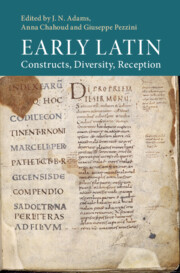Book contents
- Early Latin
- Early Latin
- Copyright page
- Dedication
- Contents
- Illustrations
- Tables
- Contributors
- Acknowledgements
- Abbreviations
- Chapter 1 Introduction: What Is ‘Early Latin’?
- Part I The Epigraphic Material
- Part II Drama
- Part III Other Genres and Fragmentary Authors
- Part IV Reception
- Chapter 20 ‘Early Latin’ and the Fragments of Atellane Comedy
- Chapter 21 Lucretius and ‘Early Latin’
- Chapter 22 Cicero and Early Dramatic Latin
- Chapter 23 Early Latin Texts in Livy
- Chapter 24 Pliny Rewrites Cato
- Chapter 25 Gellius’ Appreciation and Understanding of ‘Early Latin’
- Chapter 26 Views on ‘Early Latin’ in Grammatical Texts
- Chapter 27 Nonius Marcellus and the Shape of ‘Early Latin’
- Chapter 28 ‘Early Latin’ to Neo-Latin
- Chapter 29 Conclusions
- Bibliography
- Index Verborum
- Index of Non-Latin Words
- Index Locorum Potiorum
- Subject Index
Chapter 24 - Pliny Rewrites Cato
from Part IV - Reception
Published online by Cambridge University Press: 27 July 2023
- Early Latin
- Early Latin
- Copyright page
- Dedication
- Contents
- Illustrations
- Tables
- Contributors
- Acknowledgements
- Abbreviations
- Chapter 1 Introduction: What Is ‘Early Latin’?
- Part I The Epigraphic Material
- Part II Drama
- Part III Other Genres and Fragmentary Authors
- Part IV Reception
- Chapter 20 ‘Early Latin’ and the Fragments of Atellane Comedy
- Chapter 21 Lucretius and ‘Early Latin’
- Chapter 22 Cicero and Early Dramatic Latin
- Chapter 23 Early Latin Texts in Livy
- Chapter 24 Pliny Rewrites Cato
- Chapter 25 Gellius’ Appreciation and Understanding of ‘Early Latin’
- Chapter 26 Views on ‘Early Latin’ in Grammatical Texts
- Chapter 27 Nonius Marcellus and the Shape of ‘Early Latin’
- Chapter 28 ‘Early Latin’ to Neo-Latin
- Chapter 29 Conclusions
- Bibliography
- Index Verborum
- Index of Non-Latin Words
- Index Locorum Potiorum
- Subject Index
Summary
Cato’s de Agricultura was an important source for Pliny’s Naturalis Historia. Cato himself appears sixteen times in Pliny’s lists of sources, and in the text proper (Pliny tells us explicitly more than eighty times that he is reproducing Catonian material; most of it comes from the de Agricultura. A dozen or so passages are or purport to be direct quotations, but most are paraphrases; Catonian content in Plinian words. The present paper is a study of the linguistic features of Cato’s text that Pliny rewrites. Especially interesting features include cases in which concrete expressions are replaced by abstract nouns, simple verbs become compound (or the compounding prefix changes), a term is replaced by a synonym or synonymous expression, or the syntax is made more compact. Pliny’s adaptations of Cato’s language is read in light of his several general remarks about Cato’s style: he comments, for example, on Cato’s verbosity, diction and habitual censoriousness. The discussion shows how one ancient reader reacted to Cato’s early Latin.
- Type
- Chapter
- Information
- Early LatinConstructs, Diversity, Reception, pp. 485 - 510Publisher: Cambridge University PressPrint publication year: 2023

